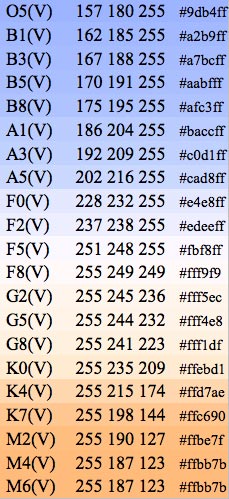The website called Today I Found Out has an interesting post on Sun factoids, including its color as designated in hex code: #FFF5F2. That code is actually taken from the site vendian.org, put together by Mitchell Charity. He has other star colors listed as well. I found the codes for different stellar types interesting.
 The star type is listed, along with the RGB and hex values. The stars go from hottest at the top to coolest at the bottom, and the Sun is roughly a G2V.
The star type is listed, along with the RGB and hex values. The stars go from hottest at the top to coolest at the bottom, and the Sun is roughly a G2V.
The colors are relatively good, in that they are blue at the top and reddish at the bottom. But I was surprised at the lack of color saturation, and that the cooler stars aren’t as red as I would think.
I have spent a lot of time at the eyepiece. Vega, an A0 dwarf star, is distinctly and brilliantly blue, almost a sapphire to the eye. Betelgeuse, an M1 supergiant, is a ruddy orange. I’ve seen a handful of cooler red giants, and to the eye they are very red, not the pastel orangey thing seen here.
Why is this? There are lots of reasons that come to my mind. One is that the way stars shine is inherently different than the way colors are represented on your screen. Stars are hot balls of luminous plasma, glowing like a blackbody. Unless you heat your monitor to that same temperature, you can only approximate the way a star shines, and the colors will be off.
Our eye perceives color oddly, too. Seeing a star against a black sky will give you a different sense of its color than if you see it on your monitor. Even putting a differently colored star in the same field wrecks your color sense. I’ll note that Charity’s star color page has a hex code for the color of planetary nebulae, and that’s a whole nuther can o’ worms.
In my opinion, doing this is an interesting exercise, and a wonderful “teaching moment” on how stars emit light and how we perceive color. But as an exercise in actually trying to mimic star colors, it’s a whole lot tougher than you might think. I’m not saying Charity’s colors are wrong, but I am saying that trying to get hex codes for star colors is like writing down the notes to Beethoven’s Ninth Symphony on paper. It’s a code, and has the right information in it, but it’s not the same as hearing the orchestra.
I’ll also note that the whole point of the first site’s article is that the Sun is white. This is actually an extremely difficult topic to understand – it’s not just scattered blue light that makes the Sun look yellow to us, and I’m still not convinced the Sun does look yellow to us. Charity links to a page about the Sun’s color written by my friend the astronomer Andrew Hamilton, which has some more info on it.
I think the real lesson here is that something we think of as simple – color – is not at all simple! The way colors are emitted by an object, the way our eyes detect color, and most importantly the way our brains interpret that signal, are actually extraordinarily complex processes. I think that’s a very important concept to keep in mind when pondering pretty much any issue: what we take for granted as simple is almost never any such thing.
Tip o’ the artist’s beret to Philippe Hamel.